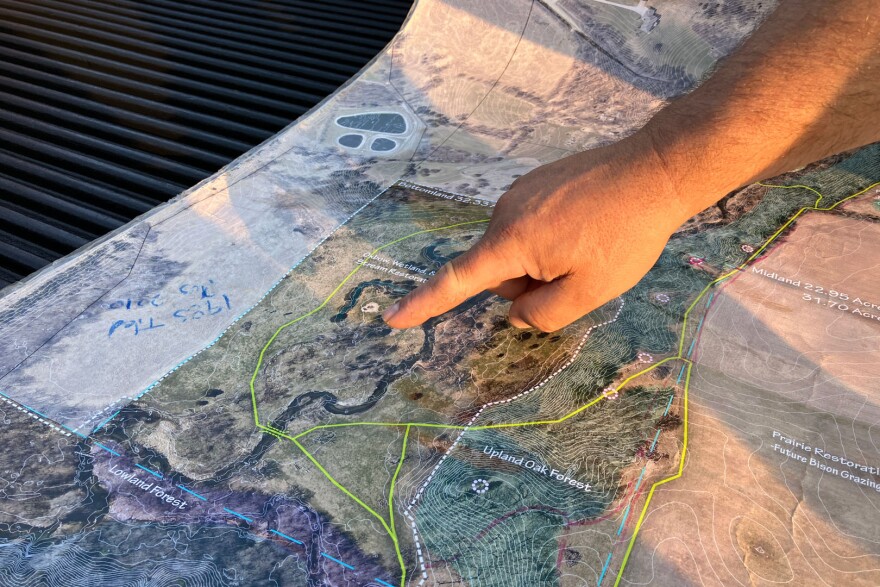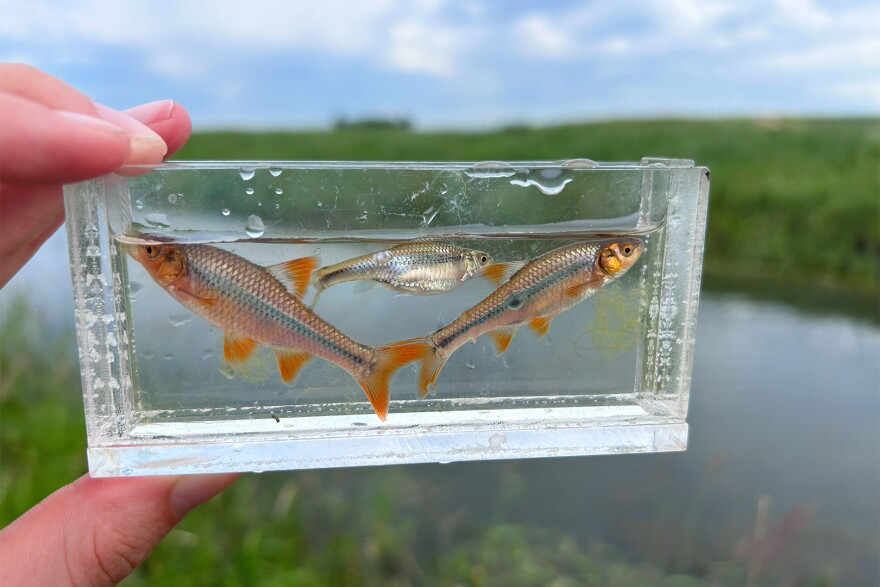Jathan Chicoine parked his truck next to a fast moving creek on his family farm in central Iowa. The water flows into the South Skunk River, a tributary of the Mississippi River.
He pointed to a depression on the other side. With support from the U.S. Fish and Wildlife Service and Practical Farmers of Iowa, decades of sediment will be removed in the coming weeks.
“We have a big goal to create as biodiverse of an ecosystem as possible, but we’re also focused on water quality where we know that the water that comes onto our property leaves in better condition,” Chicoine said.
A key piece of that vision is restoring oxbow wetlands.
These u-shaped remnants of meandering streams and rivers provide habitat for dozens of bird and fish species. In some parts of the Midwest and Great Plains, that includes an endangered minnow, the Topeka shiner.
Oxbow wetlands also store floodwater and filter nutrients. A recent study shows oxbows can remove an average of 62% of nitrates in water flowing from farm field tiles. That percentage goes up with more time, and the rate is faster with surface runoff. A lower nutrient load means cleaner water and fewer algae blooms for people downstream.
Recognizing the benefits of oxbow wetlands and efforts to restore them is relatively new. But a growing number of federal and state agencies, conservation groups and landowners are putting in the work.
“It’s meaningful for us to make a difference for those downstream,” Chicoine said.

Using nature
Karen Wilke, associate director of fresh water for The Nature Conservancy of Iowa, has been a leader in restoring oxbow wetlands for years.
“Nature wants to get back to nature, right? So we kind of just help it along its way, and it does its own thing,” Wilke said.
Not all oxbow wetlands need to be restored, according to conservation practitioners. An individual prairie stream is estimated to have more than 400, and it’s natural for them to fill in with sediment over time.
But this process has sped up rapidly since European settlement. New arrivals straightened streams and rivers and built flood controlled levees. They converted prairies, which help hold soil and water in place, into farms and cities.
Restoration involves excavating sediment and stabilizing the banks, often with a mix of native pollinator plants and cover crops, like rye or oats, which die off. Wilke said restoration has several benefits over creating new oxbows.
“It’s just so much easier to let nature come back than if you were to do it in a random spot,” Wilke said. “The soils might not be quite right. The hydrology under the ground might not feed into the wetland like you would think, and there wouldn’t be that historic seed bed of aquatic vegetation that would come back up.”
Gaining momentum
When Wilke first started restoration work a decade ago, she said she was restoring two or three oxbow wetlands per year. Now it’s around 50.
The U.S. Fish and Wildlife Service has helped to restore more than 200 oxbows in Iowa since 2001, and more than 130 oxbows in Minnesota since 2014 through its Partners for Fish and Wildlife Program. Over 95% have been on private land.
Conservation experts say lessons learned in these two states could be adopted in other parts of the Midwest.
Darrick Weissenfluh, a Fish and Wildlife Service biologist, said the number of oxbow restorations in Iowa has nearly doubled every five years, in part due to new funding opportunities related to water quality. More landowner awareness and interest is another reason.

He said three organizations – the Fish and Wildlife Service Partners For Fish and Wildlife Program, Iowa Soybean Association and The Nature Conservancy – have staff that primarily focus on outreach and education to implement oxbow restorations.
Grace Yi, the senior habitat viability coordinator at Practical Farmers of Iowa, works with landowners to figure out how conservation practices fit in with their goals and priorities. She says one of the selling points for oxbow wetlands is that they tend to be in areas where it's harder to farm and make a profit.
“Once the landowners learn about what oxbows are and the benefits of them, it's easier, I think, to turn that into habitat, since they don’t have that opportunity cost of removing production acres out,” Yi said.
There’s also aesthetic value, Yi said. Farmers and landowners have told her that they appreciate the diversity and beauty of these restored wetlands and the opportunity to see wildlife.
For some, that includes a federally endangered fish found in pockets of the Midwest and Great Plains.

The Topeka shiner
The Topeka shiner, a freshwater minnow, is an important part of the food chain and an indicator species for stream health.
It was listed as federally endangered in 1998 after disappearing from 90% of its historical range, which includes parts of Iowa, Kansas, Minnesota, Missouri, Nebraska and South Dakota.
To help the species recover, the Fish and Wildlife Service worked with partners to restore oxbow wetlands, which the Topeka shiner uses for spawning. Earlier this year, the agency recommended changing its status from “endangered” to “threatened,” an indication of success, Weissenfluh said.

Steve Herrington is the associate director of water for The Nature Conservancy in Minnesota and the Dakotas. During a recent oxbow restoration project in Minnesota, he saw large male sunfish guarding their eggs while Topeka shiners spawned above them. Their fertilized eggs “fell like snow” into the sunfish nests, he said.
Herrington said it was heartening to witness a rare and imperiled fish do something that has taken 10,000 years of co-evolution with another species.
Topeka shiners benefit from having larger fish intimidate and fight egg predators. And individual sunfish eggs are less likely to be eaten by a predator, like a crayfish, if there are more eggs in the nest.
“We saw it with our own eyes, a species recovering itself, hopefully, fingers crossed, off of the endangered species list some day,” Herrington said.
Eastern South Dakota has a population of Topeka shiners, Herrington said, and his team is interested in working with partners to replicate what’s worked well in Iowa and Minnesota.
“Here we have an example of something that landowners like, that isn’t very expensive to do, and is terribly effective, and we can prove it,” Herrington said.

Hurdles remain
The cost of oxbow wetland restorations can vary from $10,000 to $35,000. While funding exists, it can be difficult for landowners to navigate resources and find the program that works best for their situation. For example, funds are often tied to a specific watershed or require the oxbow to be fed by a field tile.
Weissenfluh also said there aren’t enough professionals with the time and expertise to do the necessary work, which includes mapping, site visits, project management and monitoring.
An oxbow restoration toolkit for conservation practitioners aims to help on that front, Wilke said.
From her experience, the biggest pinch point is getting a permit from the U.S. Corps of Engineers or Iowa Department of Natural Resources.
“We always get approved, but if we could speed that up, we could probably do [a restoration] in a couple of months,” Wilke said.
As more landowners take on these restoration projects, it can lead to more awareness, Wilke said. Sometimes it takes a neighbor to try something new.
That’s one of Chicoine’s goals with restoring Iowa’s native ecosystems – to inspire others.
“There are so many citizens, so many individuals that just really are concerned about issues of water quality, conservation,” he said. “But they don’t always know how they can make a difference.”
This story was produced in partnership with Harvest Public Media, a collaboration of public media newsrooms in the Midwest. It reports on food systems, agriculture and rural issues.


